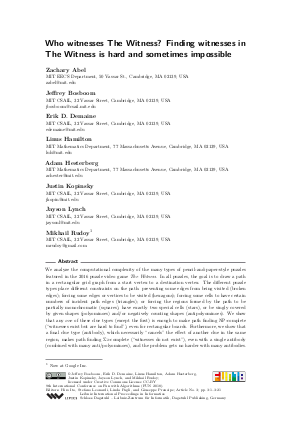Who witnesses The Witness? Finding witnesses in The Witness is hard and sometimes impossible
Authors Zachary Abel, Jeffrey Bosboom, Erik D. Demaine, Linus Hamilton, Adam Hesterberg, Justin Kopinsky, Jayson Lynch, Mikhail Rudoy
-
Part of:
Volume:
9th International Conference on Fun with Algorithms (FUN 2018)
Part of: Series: Leibniz International Proceedings in Informatics (LIPIcs)
Part of: Conference: International Conference on Fun with Algorithms (FUN) - License:
 Creative Commons Attribution 3.0 Unported license
Creative Commons Attribution 3.0 Unported license
- Publication Date: 2018-06-04
File

PDF
LIPIcs.FUN.2018.3.pdf
- Filesize: 0.75 MB
- 21 pages
Document Identifiers
Related Versions
Subject Classification
ACM Subject Classification
- Theory of computation → Problems, reductions and completeness
Keywords
- video games
- puzzles
- hardness
Metrics
- Access Statistics
-
Total Accesses (updated on a weekly basis)
0Document
0Metadata
Abstract
We analyze the computational complexity of the many types of pencil-and-paper-style puzzles featured in the 2016 puzzle video game The Witness. In all puzzles, the goal is to draw a path in a rectangular grid graph from a start vertex to a destination vertex. The different puzzle types place different constraints on the path: preventing some edges from being visited (broken edges); forcing some edges or vertices to be visited (hexagons); forcing some cells to have certain numbers of incident path edges (triangles); or forcing the regions formed by the path to be partially monochromatic (squares), have exactly two special cells (stars), or be singly covered by given shapes (polyominoes) and/or negatively counting shapes (antipolyominoes). We show that any one of these clue types (except the first) is enough to make path finding NP-complete ("witnesses exist but are hard to find"), even for rectangular boards. Furthermore, we show that a final clue type (antibody), which necessarily "cancels" the effect of another clue in the same region, makes path finding Sigma_2-complete ("witnesses do not exist"), even with a single antibody (combined with many anti/polyominoes), and the problem gets no harder with many antibodies.
Cite As Get BibTex
Zachary Abel, Jeffrey Bosboom, Erik D. Demaine, Linus Hamilton, Adam Hesterberg, Justin Kopinsky, Jayson Lynch, and Mikhail Rudoy. Who witnesses The Witness? Finding witnesses in The Witness is hard and sometimes impossible. In 9th International Conference on Fun with Algorithms (FUN 2018). Leibniz International Proceedings in Informatics (LIPIcs), Volume 100, pp. 3:1-3:21, Schloss Dagstuhl – Leibniz-Zentrum für Informatik (2018)
https://doi.org/10.4230/LIPIcs.FUN.2018.3
BibTex
@InProceedings{abel_et_al:LIPIcs.FUN.2018.3,
author = {Abel, Zachary and Bosboom, Jeffrey and Demaine, Erik D. and Hamilton, Linus and Hesterberg, Adam and Kopinsky, Justin and Lynch, Jayson and Rudoy, Mikhail},
title = {{Who witnesses The Witness? Finding witnesses in The Witness is hard and sometimes impossible}},
booktitle = {9th International Conference on Fun with Algorithms (FUN 2018)},
pages = {3:1--3:21},
series = {Leibniz International Proceedings in Informatics (LIPIcs)},
ISBN = {978-3-95977-067-5},
ISSN = {1868-8969},
year = {2018},
volume = {100},
editor = {Ito, Hiro and Leonardi, Stefano and Pagli, Linda and Prencipe, Giuseppe},
publisher = {Schloss Dagstuhl -- Leibniz-Zentrum f{\"u}r Informatik},
address = {Dagstuhl, Germany},
URL = {https://drops.dagstuhl.de/entities/document/10.4230/LIPIcs.FUN.2018.3},
URN = {urn:nbn:de:0030-drops-87944},
doi = {10.4230/LIPIcs.FUN.2018.3},
annote = {Keywords: video games, puzzles, hardness}
}
Author Details
Funding
- Rudoy, Mikhail: Now at Google Inc.
References
-
Zachary Abel, Jeffrey Bosboom, Erik D. Demaine, Linus Hamilton, Adam Hesterberg, Justin Kopinsky, Jayson Lynch, and Mikhail Rudoy. Who witnesses The Witness? Finding witnesses in The Witness is hard and sometimes impossible. arXiv:1804.10193, 2018.

-
Greg Aloupis, Erik D. Demaine, Alan Guo, and Giovanni Viglietta. Classic Nintendo games are (computationally) hard. Theoretical Computer Science, 586:135-160, 2015.

-
Erik D. Demaine and Martin L. Demaine. Jigsaw puzzles, edge matching, and polyomino packing: Connections and complexity. Graphs and Combinatorics, 23:195-208, June 2007.

-
Erik D. Demaine and Mikhail Rudoy. Tree-residue vertex-breaking: a new tool for proving hardness. In Proceedings of the 16th Scandinavian Symposium and Workshops on Algorithm Theory, 2018. arXiv:1706.07900.

-
Linus Hamilton. Braid is undecidable. arXiv:1412.0784, 2014.

-
Alon Itai, Christos H. Papadimitriou, and Jayme Luiz Szwarcfiter. Hamilton paths in grid graphs. SIAM Journal on Computing, 11(4):676-686, November 1982.

-
Donald E. Knuth and Arvind Raghunathan. The problem of compatible representatives. SIAM Journal on Discrete Mathematics, 5(3):422-427, 1992.

-
Irina Kostitsyna, Maarten Löffler, Max Sondag, Willem Sonke, and Jules Wulms. The hardness of Witness puzzles. In Abstracts from the 34th European Workshop on Computational Geometry, 2018.

- Wikipedia. The Witness (2016 video game). https://en.wikipedia.org/wiki/The_Witness_(2016_video_game), 2018.
-
Takayuki Yato. On the NP-completeness of the Slither Link puzzle (in Japanese). IPSJ SIG Notes, AL-74:25-32, 2000.

